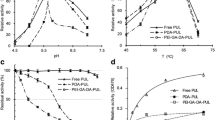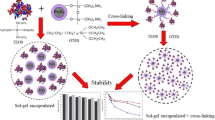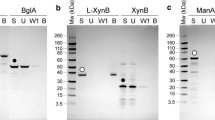Abstract
A novel pullulanase partially purified from Fontibacillus sp. was covalently immobilized on Florisil® and nano-silica through both glutaraldehyde and (3-glycidyloxypropyl)trimethoxysilane spacer arms. The pullulanase immobilized on Florisil® and nano-silica through glutaraldehyde spacer arm showed 85 and 190 % activity of its free form, respectively, whereas no activity was observed when it was immobilized on the same supports through (3-glycidyloxypropyl)trimethoxysilane spacer arm. The maximum working pHs of both the immobilized pullulanases on Florisil® and nano-silica through glutaraldehyde spacer arm were determined as 5.0; however, the maximum working pH of the free pullulanase was pH 6.0. The maximum temperatures of all the pullulanase preparations were determined as 35 °C. The apparent K m values were 1.49, 1.54, and 0.59 mg/mL pullunan, respectively, for the free and immobilized pullulanases on Florisil® and nano-silica. The corresponding apparent V max values were 0.59, 1.53, and 1.57 U mg prot.−1 min.−1. Thermal stability of pullulanases immobilized on Florisil® and nano-silica was enhanced 6.5- and 15.6-folds, respectively at 35 °C and 6.6- and 16.0-folds, respectively, at 50 °C. The pullulanases immobilized on Florisil® and nano-silica protected 71 and 90 % of their initial activities after 10 reuses.







Similar content being viewed by others
References
Leathers, T. D. (2003). Biotechnological production and applications of pullulan. Applied Microbiology and Biotechnology, 62(5), 468–473.
Domań-Pytka, M., & Bardowski, J. (2004). Pullulan degrading enzymes of bacterial origin. Critical Reviews in Microbiology, 30(2), 107–121.
Israilides, C., Smith, A., Scanlon, B., & Barnett, C. (1999). Pullulan from agro-industrial wastes. Biotechnology and Genetic Engineering Reviews, 16(1), 309–324.
Kuroiwa, T., Shoda, H., Ichikawa, S., Sato, S., & Mukataka, S. (2005). Immobilization and stabilization of pullulanase from Klebsiella pneumoniae by a multipoint attachment method using activated agar gel supports. Process Biochemistry, 40(8), 2637–2642.
Singh, R. S., Saini, G. K., & Kennedy, J. F. (2010). Maltotriose syrup preparation from pullulan using pullulanase. Carbohydrate Polymers, 80(2), 401–407.
Atia, K. S., Ismail, S. A., El-Arnaouty, M. B., & Dessouki, A. M. (2003). Use of co-immobilized beta-amylase and pullulanase in reduction of saccharification time of starch and increase in maltose yield. Biotechnology Progress, 19(3), 853–857.
Talekar, S., Pandharbale, A., Ladole, M., Nadar, S., Mulla, M., Japhalekar, K., Pattankude, K., & Arage, D. (2013). Carrier free co-immobilization of alpha amylase, glucoamylase and pullulanase as combined cross-linked enzyme aggregates (combi-CLEAs): a tri-enzyme biocatalyst with one pot starch hydrolytic activity. Bioresource Technology, 147, 269–275.
Roy, I., & Gupta, M. N. (2004). Hydrolysis of starch by a mixture of glucoamylase and pullulanase entrapped individually in calcium alginate beads. Enzyme and Microbial Technology, 34(1), 26–32.
Hii, S. L., Tan, J. S., Ling, T. C., & Ariff, A. B. (2012). Pullulanase: role in starch hydrolysis and potential industrial applications. Journal of Enzyme Research, 2012, 1–14.
Sheldon, R. A. (2007). Enzyme immobilization: the quest for optimum performance. Advanced Synthesis & Catalysis, 349(8-9), 1289–1307.
DiCosimo, R., McAuliffe, J., Poulose, A. J., & Bohlmann, G. (2013). Industrial use of immobilized enzymes. Chemical Society Reviews, 42(15), 6437–6474.
Dessouki, A. M., Issa, G. I., & Atia, K. S. (2001). Pullulanase immobilization on natural and synthetic polymers. Journal of Chemical Technology & Biotechnology, 76(7), 700–706.
Zhang, L., Zhu, X., Zheng, S., & Sun, H. (2009). Photochemical preparation of magnetic chitosan beads for immobilization of pullulanase. Biochemical Engineering Journal, 46(1), 83–87.
Singh, R. S., Saini, G. K., & Kennedy, J. F. (2010). Covalent immobilization and thermodynamic characterization of pullulanase for the hydrolysis of pullulan in batch system. Carbohydrate Polymers, 81(2), 252–259.
Long, J., Jiao, A., Wei, B., Wu, Z., Zhang, Y., Xu, X., & Jin, Z. (2014). A novel method for pullulanase immobilized onto magnetic chitosan/Fe3O4 composite nanoparticles by in situ preparation and evaluation of the enzyme stability. Journal of Molecular Catalysis B: Enzymatic, 109, 53–61.
Ali, G., Dulong, V., Gasmi, S. N., Rihouey, C., Picton, L., & Le Cerf, D. (2015). Covalent immobilization of pullulanase on alginate and study of its hydrolysis of pullulan. Biotechnology Progress, 31(4), 883–889.
Cao, L. (2006), In carrier-bound immobilized enzymes, Cao, L., (ed), Wiley-VCH Verlag GmbH & Co. KGaA, Weinheim, pp. 169–316.
dos Santos, J. C. S., Barbosa, O., Ortiz, C., Berenguer-Murcia, A., Rodrigues, R. C., & Fernandez-Lafuente, R. (2015). Importance of the support properties for immobilization or purification of enzymes. CHEMCATCHEM, 7(16), 2413–2432.
Barbosa, O., Ortiz, C., Berenguer-Murcia, A., Torres, R., Rodrigues, R. C., & Fernandez-Lafuente, R. (2014). Glutaraldehyde in bio-catalysts design: a useful crosslinker and a versatile tool in enzyme immobilization. RSC Advances, 4, 1583–1600.
Hwang, S., Lee, K.-T., Park, J.-W., Min, B.-R., Haam, S., Ahn, I.-S., & Jung, J.-K. (2004). Stability analysis of Bacillus stearothermophilus L1 lipase immobilized on surface-modified silica gels. Biochemical Engineering Journal, 17(2), 85–90.
Tukel, S. S., & Alptekin, O. (2004). Immobilization and kinetics of catalase onto magnesium silicate. Process Biochemistry, 39(12), 2149–2155.
Alptekin, Ö., Tükel, S. S., Yıldırım, D., & Alagöz, D. (2009). Characterization and properties of catalase immobilized onto controlled pore glass and its application in batch and plug-flow type reactors. Journal of Molecular Catalysis B: Enzymatic, 58(1-4), 124–131.
Mateo, C., Grazu, V., Pessela, B. C., Montes, T., Palomo, J. M., Torres, R., Lopez-Gallego, F., Fernandez-Lafuente, R., & Guisan, J. M. (2007). Advances in the design of new epoxy supports for enzyme immobilization-stabilization. Biochemical Society Transactions, 35(6), 1593–1601.
Barbosa, O., Torres, R., Ortiz, C., Berenguer-Murcia, Á., Rodrigues, R. C., & Fernandez-Lafuente, R. (2013). Heterofunctional supports in enzyme immobilization: from traditional immobilization protocols to opportunities in tuning enzyme properties. Biomacromolecules, 14(8), 2433–2462.
Ansari, S. A., & Husain, Q. (2012). Potential applications of enzymes immobilized on/in nano materials: a review. Biotechnology Advances, 30(3), 512–523.
Talekar, S., Ghodake, V., Ghotage, T., Rathod, P., Deshmukh, P., Nada, R. S., Mulla, M., & Ladole, M. (2012). Novel magnetic cross-linked enzyme aggregates (magnetic CLEAs) of alpha amylase. Bioresource Technology, 123, 542–547.
Lei, C., Shin, Y., Liu, J., & Ackerman, E. J. (2002). Entrapping enzyme in a functionalized nanoporous support. Journal of the American Chemical Society, 124, 11242–11243.
Mitchell, D. T., Lee, S. B., Trofin, L., Li, N., Nevanen, T. K., Söderlund, H., & Martin, C. R. (2002). Smart nanotubes for bioseparations and biocatalysis. Journal of the American Chemical Society, 124(38), 11864–11865.
Wang, P. (2006). Nanoscale biocatalyst systems. Current Opinion in Biotechnology, 17(6), 574–579.
Sundberg, L., & Porath, J. (1974). Preparation of adsorbents for biospecific affinity chromatography: I. Attachment of group-containing ligands to insoluble polymers by means of bifunctional oxiranes. Journal of Chromatography. A, 90(1), 87–98.
Bradford, M. M. (1976). A rapid and sensitive method for the quantitation of microgram quantities of protein utilizing the principle of protein-dye binding. Analytical Biochemistry, 72, 248–254.
Miller, G. L. (1959). Use of dinitrosalicylic acid reagent for determination of reducing sugar. Analytical Chemistry, 31(3), 426–428.
Talekar, S., Nadar, S., Joshi, A., & Joshi, G. (2014). Pectin cross-linked enzyme aggregates (pectin-CLEAs) of glucoamylase. RSC Advances, 4, 59444–59453.
Nadar, S. S., Muley, A. B., Ladole, M. R., & Joshi, P. U. (2016). Macromolecular cross-linked enzyme aggregates (M-CLEAs) of alpha-amylase. International Journal of Biological Macromolecules, 84, 69–78.
Nadar, S. S., & Rathod, V. K. (2016). Magnetic macromolecular cross linked enzyme aggregates (CLEAs) of glucoamylase. Enzyme and Microbial Technology, 83, 78–87.
Alptekin, O., Tukel, S. S., Yildirim, D., & Alagoz, D. (2011). Covalent immobilization of catalase onto spacer-arm attached modified florisil: characterization and application to batch and plug-flow type reactor systems. Enzyme and Microbial Technology, 49, 547–554.
Yildirim, D., Tukel, S. S., Alagoz, D., & Alptekin, O. (2011). Preparative-scale kinetic resolution of racemic styrene oxide by immobilized epoxide hydrolase. Enzyme and Microbial Technology, 49(6-7), 555–559.
Long, J., Wu, Z., Li, X., Xu, E., Xu, X., Jin, Z., & Jiao, A. (2015). New method for the immobilization of pullulanase onto hybrid magnetic (Fe3O4-kappa-carrageenan) nanoparticles by electrostatic coupling with pullulanase/chitosan complex. Journal of Agricultural and Food Chemistry., 63(13), 3534–3542.
Acknowledgments
The authors declare that they have no competing interests.
Author information
Authors and Affiliations
Corresponding author
Rights and permissions
About this article
Cite this article
Alagöz, D., Yildirim, D., Güvenmez, H.K. et al. Covalent Immobilization and Characterization of a Novel Pullulanase from Fontibacillus sp. Strain DSHK 107 onto Florisil® and Nano-silica for Pullulan Hydrolysis. Appl Biochem Biotechnol 179, 1262–1274 (2016). https://doi.org/10.1007/s12010-016-2063-2
Received:
Accepted:
Published:
Issue Date:
DOI: https://doi.org/10.1007/s12010-016-2063-2




